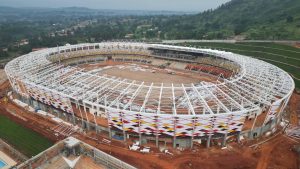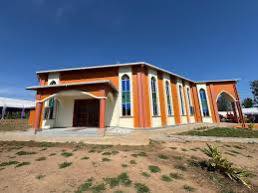
#OutToLunch: Hoima City Stadium provides a blueprint for Uganda’s infrastructural development
OutToLunch: Hoima City Stadium provides a blueprint for Uganda’s infrastructural development By Denis Jjuuko Ugandans may be consumed with what is taking place at the Mandela National Stadium at Namboole where Uganda is hosting some continental matches alongside their Pamoja partners Kenya and Tanzania. The three East African countries are jointly hosting the African Nations Championship (Chan), the precursor to Africa Nations Cup (Afcon), the continental soccer showpiece, which will take place in 2027. Hosting Afcon has always been largely the privilege of west and north African countries. This is the first time that East Africa will be hosting the soccer extravaganza. To do so, there was a need for stadiums and other infrastructure that meet the continental or even international standards. Namboole has been upgraded hence the ongoing Chan tournament. But what is also catching many people’s attention off the refurbished Namboole pitch is something that is taking place some 210km away in the oil rich city of Hoima. When Uganda was awarded the co-hosting rights of Afcon, many people wondered where would the tournament be held. Only Namboole had a chance of meeting the requirements albeit with some major modifications. New stadiums had to be built. Ugandans laughed hard and memes started flying on social media. Not because they are unpatriotic as some people quickly label those with divergent views. They had seen a project too many that couldn’t get done on time. They saw Uganda spending many decades constructing the 21km Northern Bypass that by the time it was completed, some cheeky people had started calling it a Bypath. They had heard endless stories about many infrastructure projects. The Jinja-Kampala Expressway, the Mpigi-Kampala Expressway and even easy to do small-small projects like Kyaliwajjala-Matugga road take forever to be done. They had become skeptical given the years it has taken Lubowa Specialized Hospital to get the building beyond the plinth wall. Airport terminal buildings? Another day please. They expected Hoima City Stadium to follow a similar path. Perhaps, because this involves some continental body in the Confederation of African Football (CAF), organisers of Afcon, the country finally awarded a contract to somebody who seems to know what they are doing in SUMMA, a Turkish outfit that has built a reputation for building stadiums in Africa and handing them over in time. What they have done since construction commenced in Hoima in September 2024 is sort of a miracle by Ugandan standards. With a budget of US$129m and constructing a 20,000-seat stadium, they have shown that a project can be worked on as scheduled. And I say this well knowing that they haven’t completed the job. Given the progress that they have made, there is no doubt that they won’t complete the job ahead of schedule. The Hoima City Stadium contractor is perhaps new in Uganda and hasn’t caught the usual bug. They have not blamed the rains like most contractors do. They have not said they can’t get materials because of the war in the Middle East or Ukraine. They haven’t blamed forex fluctuations. They haven’t blamed the invisible Powers from Above. They haven’t claimed local politicians are against the project. They have said nothing about witchcraft. They have not said Ugandans are lazy, don’t want to work and report for work while clutching sachets of illicit beverages. They have not said they can’t work at night. They have not said there is no budget or some release from the Ministry of Finance delayed. They have not appeared at any parliamentary committee to beg for this or that. Nobody has seen a letter from them asking the president for this or the other. They have simply gone on with the assignment. They have shown that Rome can be built in one day if we focused on it. That government infrastructural projects can be started and worked on as scheduled. And since we love benchmarking, the SUMMA project manager, once has finished their assignment, maybe should go on a workshop spree, teaching our contractors and their supervisors that projects today shouldn’t take as much time as building St Peter’s Basilica or the Notre Dame. And it isn’t difficult to complete projects on time. If you see an official whose desk is full of files, don’t then make him the project manager. If he can’t read the files on his desk on time, how would he manage a project that needs to be delivered on time? If money isn’t available, then don’t embark on launching the project. And hire a competent contractor. Hoima City Stadium is providing a blueprint we must all embrace. The writer is a communication and visibility consultant. djjuuko@gmail.com

